Urry D.W. (Ed.) What Sustains Life? : Consilient Mechanisms for Protein-Based Machines and Materials
Подождите немного. Документ загружается.

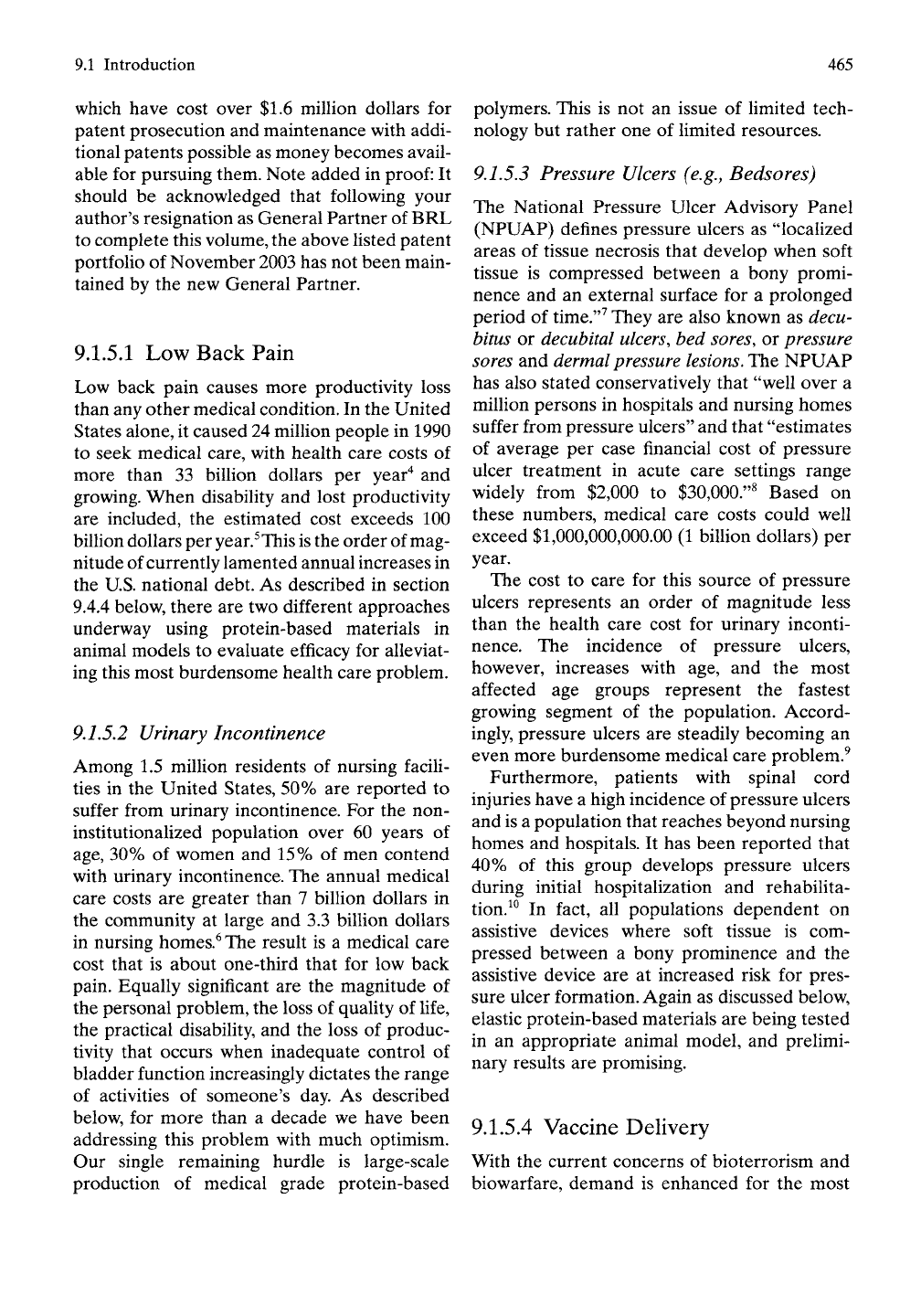
9.1 Introduction 465
which have cost over $1.6 miUion dollars for
patent prosecution and maintenance with addi-
tional patents possible as money becomes avail-
able for pursuing them. Note added in
proof:
It
should be acknowledged that following your
author's resignation as General Partner of BRL
to complete this
volume,
the above listed patent
portfolio of November
2003
has not been main-
tained by the new General Partner.
9.1.5.1 Low Back Pain
Low back pain causes more productivity loss
than any other medical condition. In the United
States alone, it caused 24 million people in 1990
to seek medical care, with health care costs of
more than 33 billion dollars per year"^ and
growing. When disability and lost productivity
are included, the estimated cost exceeds 100
biUion dollars per year.^This
is
the order of mag-
nitude of currently lamented annual increases in
the U.S. national debt. As described in section
9.4.4 below, there are two different approaches
underway using protein-based materials in
animal models to evaluate efficacy for alleviat-
ing this most burdensome health care problem.
9.1.5.2 Urinary Incontinence
Among 1.5 milhon residents of nursing faciU-
ties in the United States, 50% are reported to
suffer from urinary incontinence. For the non-
institutionalized population over 60 years of
age,
30% of women and 15% of men contend
with urinary incontinence. The annual medical
care costs are greater than 7 billion dollars in
the community at large and 3.3 biUion dollars
in nursing
homes.^
The result is a medical care
cost that is about one-third that for low back
pain. Equally significant are the magnitude of
the personal problem, the loss of quality of life,
the practical disability, and the loss of produc-
tivity that occurs when inadequate control of
bladder function increasingly dictates the range
of activities of someone's day. As described
below, for more than a decade we have been
addressing this problem with much optimism.
Our single remaining hurdle is large-scale
production of medical grade protein-based
polymers. This is not an issue of limited tech-
nology but rather one of limited resources.
9.1.5.3 Pressure Ulcers (e.g., Bedsores)
The National Pressure Ulcer Advisory Panel
(NPUAP) defines pressure ulcers as "localized
areas of tissue necrosis that develop when soft
tissue is compressed between a bony promi-
nence and an external surface for a prolonged
period of time."^ They are also known as decu-
bitus or decubital
ulcers,
bed sores, or pressure
sores and
dermal pressure
lesions.
The NPUAP
has also stated conservatively that "well over a
million persons in hospitals and nursing homes
suffer from pressure
ulcers"
and that "estimates
of average per case financial cost of pressure
ulcer treatment in acute care settings range
widely from $2,000 to $30,000."^ Based on
these numbers, medical care costs could well
exceed $1,000,000,000.00 (1 bilHon dollars) per
year.
The cost to care for this source of pressure
ulcers represents an order of magnitude less
than the health care cost for urinary inconti-
nence. The incidence of pressure ulcers,
however, increases with age, and the most
affected age groups represent the fastest
growing segment of the population. Accord-
ingly, pressure ulcers are steadily becoming an
even more burdensome medical care problem.^
Furthermore, patients with spinal cord
injuries have a high incidence of pressure ulcers
and is a population that reaches beyond nursing
homes and hospitals. It has been reported that
40%
of this group develops pressure ulcers
during initial hospitalization and rehabilita-
tion.^^ In fact, all populations dependent on
assistive devices where soft tissue is com-
pressed between a bony prominence and the
assistive device are at increased risk for pres-
sure ulcer formation. Again as discussed below,
elastic protein-based materials are being tested
in an appropriate animal model, and prelimi-
nary results are promising.
9.1.5.4 Vaccine Delivery
With the current concerns of bioterrorism and
biowarfare, demand is enhanced for the most
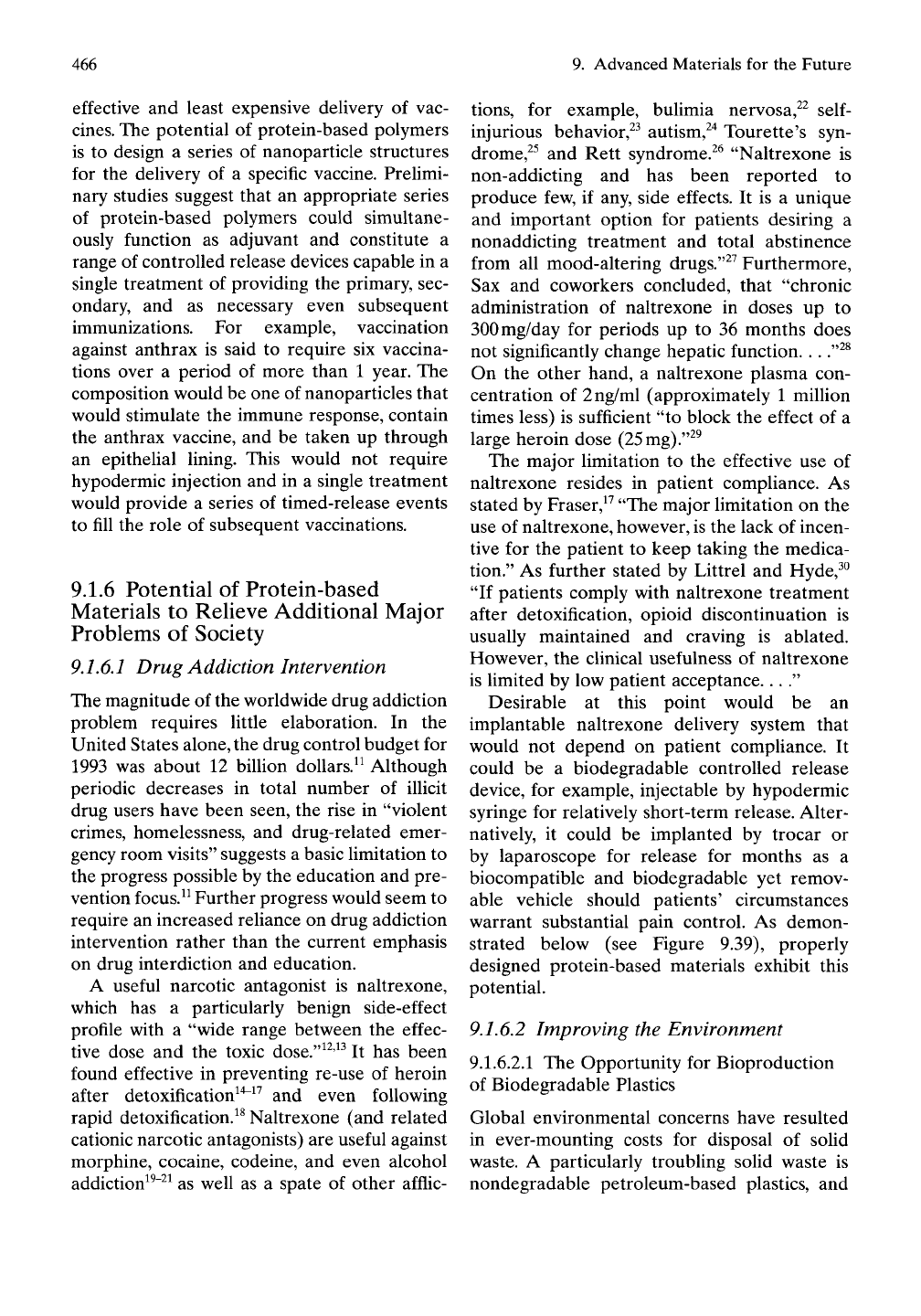
466
9. Advanced Materials for the Future
effective and least expensive delivery of vac-
cines.
The potential of protein-based polymers
is to design a series of nanoparticle structures
for the delivery of a specific vaccine. Prelimi-
nary studies suggest that an appropriate series
of protein-based polymers could simultane-
ously function as adjuvant and constitute a
range of controlled release devices capable in a
single treatment of providing the primary, sec-
ondary, and as necessary even subsequent
immunizations. For example, vaccination
against anthrax is said to require six vaccina-
tions over a period of more than 1 year. The
composition would be one of nanoparticles that
would stimulate the immune response, contain
the anthrax vaccine, and be taken up through
an epitheUal fining. This would not require
hypodermic injection and in a single treatment
would provide a series of timed-release events
to fill the role of subsequent vaccinations.
9.1.6 Potential of Protein-based
Materials to Relieve Additional Major
Problems of Society
9.1.6.1 Drug Addiction Intervention
The magnitude of the worldwide drug addiction
problem requires fittle elaboration. In the
United States alone, the drug control budget for
1993 was about 12 bilUon doUars.^^ Although
periodic decreases in total number of illicit
drug users have been seen, the rise in "violent
crimes, homelessness, and drug-related emer-
gency room visits" suggests a basic limitation to
the progress possible by the education and pre-
vention focus.^^ Further progress would seem to
require an increased refiance on drug addiction
intervention rather than the current emphasis
on drug interdiction and education.
A useful narcotic antagonist is naltrexone,
which has a particularly benign side-effect
profile with a "wide range between the effec-
tive dose and the toxic dose."^^'^^ It has been
found effective in preventing re-use of heroin
after detoxification^"^^^ and even following
rapid detoxification.^^ Naltrexone (and related
cationic narcotic antagonists) are useful against
morphine, cocaine, codeine, and even alcohol
addiction^^"^^ as well as a spate of other afflic-
tions,
for example, bulimia nervosa,^^
self-
injurious behavior,^^ autism,^"^ Tourette's syn-
drome,^^ and Rett syndrome.^^ "Naltrexone is
non-addicting and has been reported to
produce few, if any, side effects. It is a unique
and important option for patients desiring a
nonaddicting treatment and total abstinence
from all mood-altering drugs."^^ Furthermore,
Sax and coworkers concluded, that "chronic
administration of naltrexone in doses up to
300mg/day for periods up to 36 months does
not significantly change hepatic function... ."^^
On the other hand, a naltrexone plasma con-
centration of 2ng/ml (approximately 1 million
times less) is sufficient "to block the effect of a
large heroin dose
(25
mg)."^^
The major limitation to the effective use of
naltrexone resides in patient compliance. As
stated by Fraser,^^ "The major limitation on the
use of naltrexone, however, is the lack of incen-
tive for the patient to keep taking the medica-
tion." As further stated by Littrel and Hyde,^^
"If patients comply with naltrexone treatment
after detoxification, opioid discontinuation is
usually maintained and craving is ablated.
However, the clinical usefulness of naltrexone
is limited by low patient acceptance "
Desirable at this point would be an
implantable naltrexone delivery system that
would not depend on patient compliance. It
could be a biodegradable controlled release
device, for example, injectable by hypodermic
syringe for relatively short-term release. Alter-
natively, it could be implanted by trocar or
by laparoscope for release for months as a
biocompatible and biodegradable yet remov-
able vehicle should patients' circumstances
warrant substantial pain control. As demon-
strated below (see Figure 9.39), properly
designed protein-based materials exhibit this
potential.
9.1.6.2 Improving the Environment
9.1.6.2.1 The Opportunity for Bioproduction
of Biodegradable Plastics
Global environmental concerns have resulted
in ever-mounting costs for disposal of soHd
waste. A particularly troubling solid waste is
nondegradable petroleum-based plastics, and

9.1 Introduction 467
the toxic and hazardous chemicals required for
the production of petroleum-based plastics
buttress concerns. These issues have increased
demand for polymers that are biodegradable,
of benign production, and preferably from a
renewable
resource.
This is evidenced in part by
the Maritime Pollution (MARPOL) Treaty of
1995 prohibiting disposal of plastics at sea due
to damage to the marine environment and
by the earlier Plastic, Pollution Research and
Control Act of 1987 (Public Law 100-220).
9.1.6.2.2 Protein-based Materials as Plastics
With the appropriate composition, protein-
based polymers are plastics; as such they
provide a promising answer to the above envi-
ronmental problems. Petroleum-based plastics
are made from an exhaustible, nonrenewable
resource and require toxic and hazardous
chemicals in their production. In contrast,
protein-based polymers can be produced from
renewable resources, by microorganisms and
plants, and their processing can be water based,
not requiring noxious chemicals. Protein-based
plastics are inherently biodegradable and can
be programmed with compositions resulting
in lifetimes lasting from days to decades, as
desired, depending on the anticipated environ-
ment. Petroleum-based plastics mean death for
the fishes, whereas protein-based plastics mean
food for the fishes.
Protein-based polymers have the potential to
surpass the polyesters and other polymers
because they can be directly produced in
microorganisms and plants by recombinant
DNA technology resulting in the capacity for
diverse and precisely controlled composition
and sequence. This is not possible with any
other polymer, and it increases range of
properties and the numbers of applications.
Remarkably, with the proper design of compo-
sition, protein-based materials can be thermo-
plastics, melting at temperatures as much as
100°C below their decomposition tempera-
tures.
Therefore, they can be molded, extruded,
or drawn into shapes as desired. Aspects of
protein-based materials as plastics is also
considered below.
9.1.7 Analogy Between the Early
Search for a Commercial Success for
Computers and the Current Search
for a Commercial Success for
Protein-based Materials
9.1.7.1 Development of
the ''Killer
App''
for the Extraordinary Capacities
of Computers
During the early years of the development of
uses for computers, the founding entrepreneurs
were searching for what they called the "killer
application" or "killer app" for short. The
"killer app" was the application that would
make this extraordinary computational capac-
ity a commercial success. There was certainty in
the eventuality of dramatic success, but there
was also uncertainty as to what the "killer app"
would
be.
As we now know, the "killer app" that
launched the industry was the Visicalc system,
$100 software package and a $2,000 computer.
Visicalc provided a solution with which every
company could readily analyze budgets and
forecast expenditures for any desired scenario.
The designation computer once exclusively
meant the capacity for carrying out the most
challenging number crunching. It was not antic-
ipated at the time that computing would come
to include word processing, accessing of infor-
mation on the Internet, and even game playing.
There is analogy in the development of
protein-based materials. Bioelastics, Inc., the
general partner to Bioelastics Research Ltd.
(BRL),
has been working for about 15 years to
arrive at a "killer app" that could launch the
protein-based material industry. More specifi-
cally, BRL has been developing the scientific
and intellectual property foundation that would
pave the way for the extraordinary materials
capacity of protein-based polymers to result in
successful commercial applications.
The author's efforts toward identifying appli-
cations go back more than two decades and are
recorded in the first patent application filed on
August 14,1978, to use cross-linked elastomeric
polypentapeptides as "artificial vascular wall"
(United States Patent No. 4,187,852, which
patent issued on February 12, 1980; see Table
9.1).
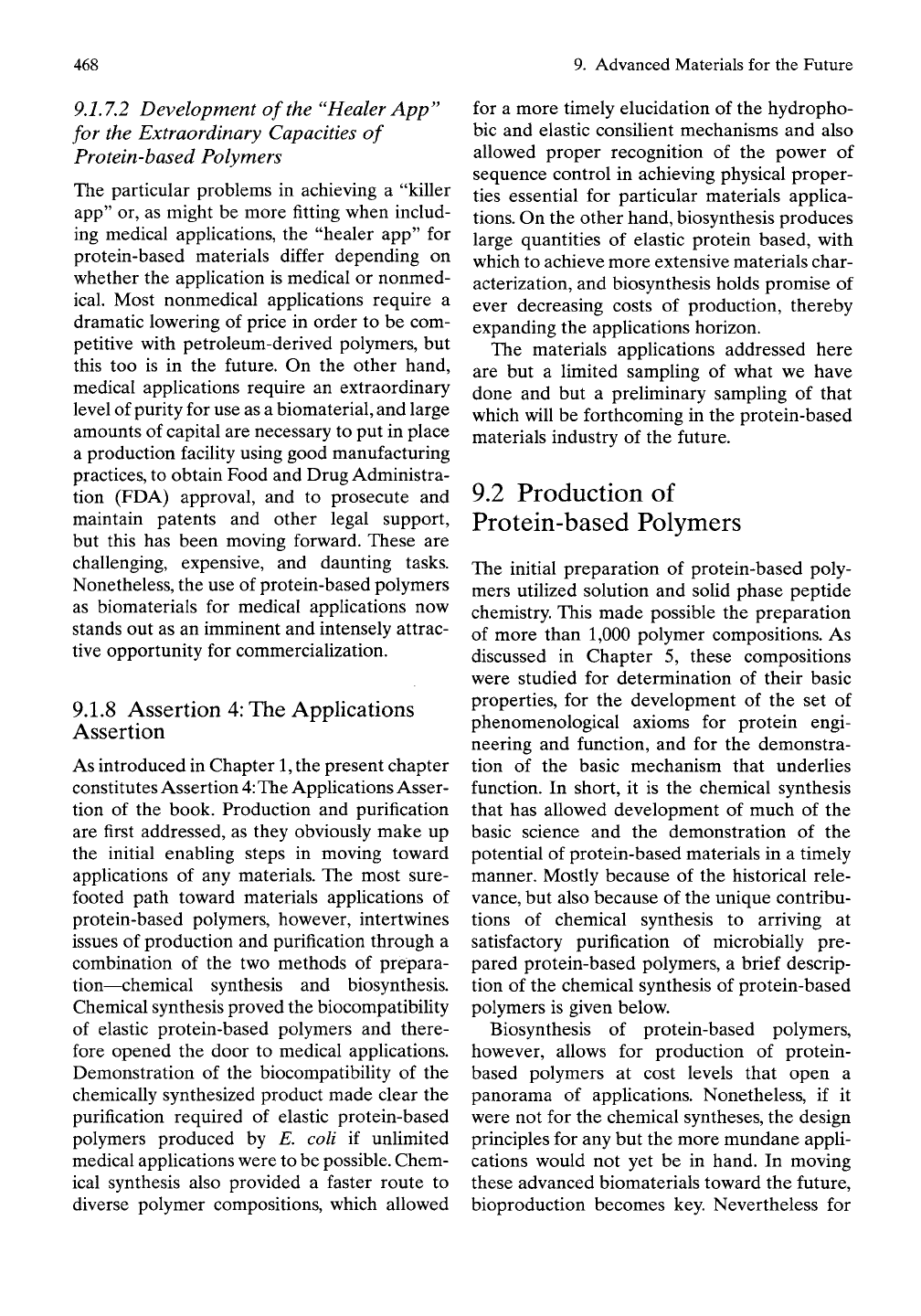
468
9. Advanced Materials for the Future
9,1.72 Development of the ''Healer App"
for the Extraordinary Capacities of
Protein-based Polymers
The particular problems in achieving a "killer
app"
or, as might be more fitting when includ-
ing medical applications, the "healer app" for
protein-based materials differ depending on
whether the application is medical or nonmed-
ical. Most nonmedical applications require a
dramatic lowering of price in order to be com-
petitive with petroleum-derived polymers, but
this too is in the future. On the other hand,
medical applications require an extraordinary
level of purity for use as a biomaterial, and large
amounts of capital are necessary to put in place
a production facility using good manufacturing
practices, to obtain Food and Drug Administra-
tion (FDA) approval, and to prosecute and
maintain patents and other legal support,
but this has been moving forward. These are
challenging, expensive, and daunting tasks.
Nonetheless, the use of protein-based polymers
as biomaterials for medical applications now
stands out as an imminent and intensely attrac-
tive opportunity for commercialization.
9.1.8 Assertion
4:
The Applications
Assertion
As introduced in Chapter
1,
the present chapter
constitutes Assertion
4:
The AppUcations Asser-
tion of the book. Production and purification
are first addressed, as they obviously make up
the initial enabling steps in moving toward
applications of any materials. The most sure-
footed path toward materials applications of
protein-based polymers, however, intertwines
issues of production and purification through a
combination of the two methods of prepara-
tion—chemical synthesis and biosynthesis.
Chemical synthesis proved the biocompatibility
of elastic protein-based polymers and there-
fore opened the door to medical applications.
Demonstration of the biocompatibility of the
chemically synthesized product made clear the
purification required of elastic protein-based
polymers produced by E. coli if unlimited
medical applications were to be possible. Chem-
ical synthesis also provided a faster route to
diverse polymer compositions, which allowed
for a more timely elucidation of the hydropho-
bic and elastic consilient mechanisms and also
allowed proper recognition of the power of
sequence control in achieving physical proper-
ties essential for particular materials applica-
tions.
On the other hand, biosynthesis produces
large quantities of elastic protein based, with
which to achieve more extensive materials char-
acterization, and biosynthesis holds promise of
ever decreasing costs of production, thereby
expanding the appUcations horizon.
The materials appUcations addressed here
are but a limited sampling of what we have
done and but a preliminary sampling of that
which will be forthcoming in the protein-based
materials industry of the future.
9.2 Production of
Protein-based Polymers
The initial preparation of protein-based poly-
mers utilized solution and soUd phase peptide
chemistry. This made possible the preparation
of more than 1,000 polymer compositions. As
discussed in Chapter 5, these compositions
were studied for determination of their basic
properties, for the development of the set of
phenomenological axioms for protein engi-
neering and function, and for the demonstra-
tion of the basic mechanism that underlies
function. In short, it is the chemical synthesis
that has allowed development of much of the
basic science and the demonstration of the
potential of protein-based materials in a timely
manner. Mostly because of the historical rele-
vance, but also because of the unique contribu-
tions of chemical synthesis to arriving at
satisfactory purification of microbially pre-
pared protein-based polymers, a brief descrip-
tion of the chemical synthesis of protein-based
polymers is given below.
Biosynthesis of protein-based polymers,
however, allows for production of protein-
based polymers at cost levels that open a
panorama of appUcations. Nonetheless, if it
were not for the chemical syntheses, the design
principles for any but the more mundane appli-
cations would not yet be in hand. In moving
these advanced biomaterials toward the future,
bioproduction becomes key. Nevertheless for
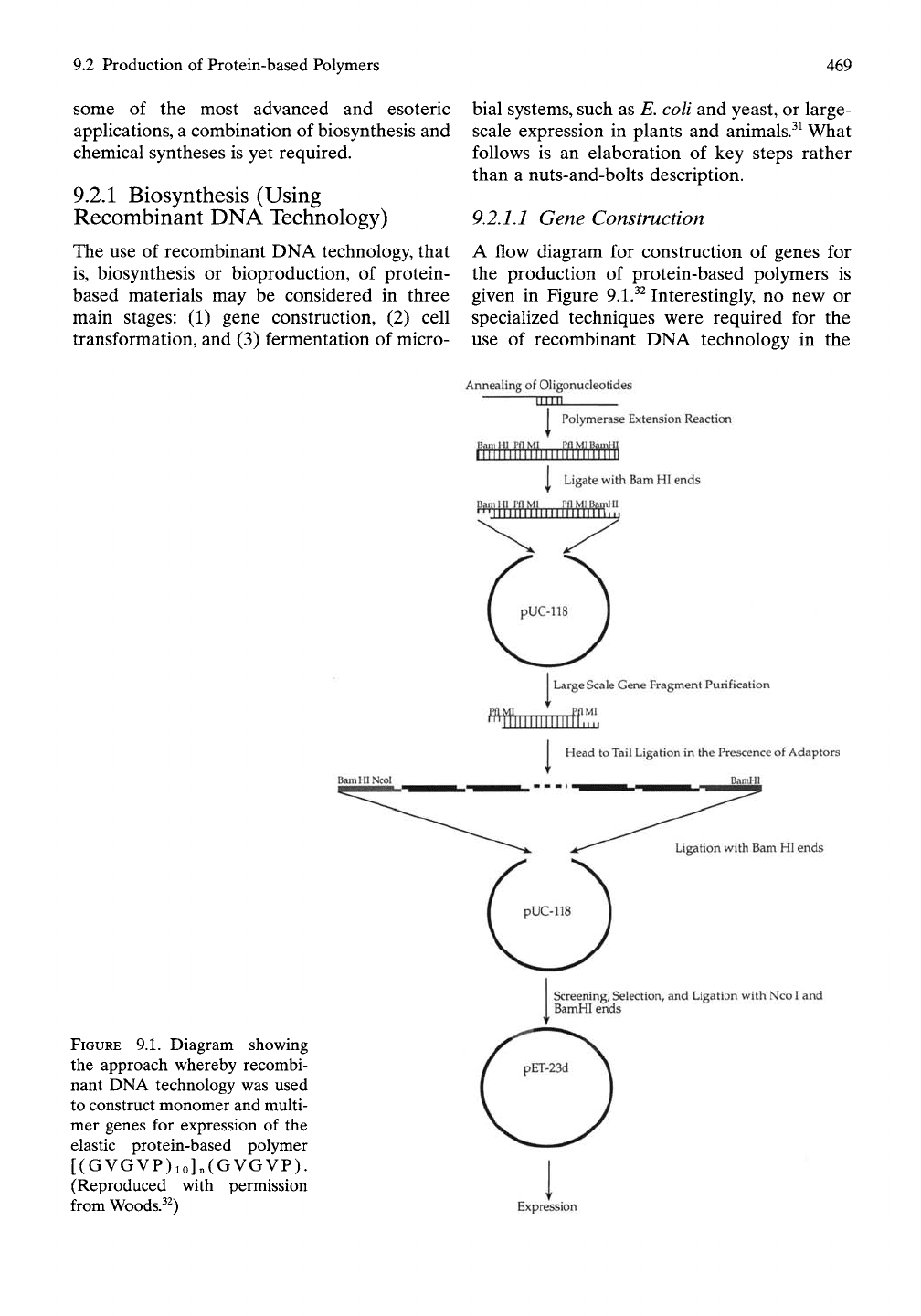
9.2 Production
of
Protein-based Polymers
469
some
of the
most advanced
and
esoteric
applications,
a
combination
of
biosynthesis
and
chemical syntheses
is yet
required.
9.2.1 Biosynthesis (Using
Recombinant DNA Technology)
The
use of
recombinant
DNA
technology, that
is,
biosynthesis
or
bioproduction,
of
protein-
based materials
may be
considered
in
three
main stages:
(1)
gene construction,
(2)
cell
transformation,
and (3)
fermentation
of
micro-
bial systems, such
as E.
coli
and
yeast,
or
large-
scale expression
in
plants
and
animals.^^ What
follows
is an
elaboration
of key
steps rather
than
a
nuts-and-bolts description.
9.2.1.1
Gene Construction
A flow diagram
for
construction
of
genes
for
the production
of
protein-based polymers
is
given
in
Figure
9.1.^^
Interestingly,
no new or
specialized techniques were required
for the
use
of
recombinant
DNA
technology
in the
Annealing
of
Oligonucleotides
mrm
Polymerase Extension Reaction
I Ligate with Bam HI ends
Large Scale Gene Fragment Purification
MMIIIIIHrfmi
Head to Tail Ligation
in
the Prescence
of
Adaptors
Ligation with Bam HI ends
Screening, Selection, and Ligation with Nco
I
and
BamHI ends
FIGURE
9.1. Diagram showing
the approach whereby recombi-
nant DNA technology was used
to construct monomer and multi-
mer genes
for
expression
of the
elastic protein-based polymer
[(GVGVP)io]n(GVGVP).
(Reproduced with permission
from Woods. ^^) Expression

470
9. Advanced Materials for the Future
production of protein-based polymers. The
techniques utilized have been known in molec-
ular biology for two decades, including the key
awareness of the need to make use of codon
redundancy for repetitive sequences.
9.2.1.1.1 Preparation of Monomer Genes and
the PCR Technique
A basic monomer gene or a gene segment is
chosen such that the total length would be no
more than about 150 bases, encoding for a se-
quence of 50 amino acid residues. For example,
consider the basic monomer gene (GVGVP)io,
which would require a sequence of 150 bases, a
triplet codon for each amino acid residue. From
the virtual beginning of these efforts in the early
1980s, there was concern for what is called
homologous recombination wherein identical
repeating base sequences would loop-out and
re-estabUsh base pairing to result in deletion of
the looped-out gene sequence.
Also very early it was appreciated that the
way to limit deletions was to utilize codon
redundancy. For example, four different triplet
base sequences encode for the glycine (Gly, G)
residue, namely, GGU, GGC, GGA, and GCG,
and another four for the valine
(Val,
V) residue,
namely, GUU, GUC, GUA, and GUG. These
and other codon redundancies may be seen in
the genetic code given in Table 6.2. This means,
for genes encoding GVGVP repeats, that differ-
ent codons can be used for the
V,
G, and P of the
different repeats and even within the same
repeat. Thus, while there are 10 repeats at the
protein-based polymer level for (GVGVP)io,
there are no repeats at the DNA level for the 150
base sequence that encodes for (GVGVP)io.
Furthermore, while all Life uses the same
genetic code, different species do have different
codon preferences. In general, therefore, when
designing a gene to be expressed in E. coli, the
codon preferences for E. coli are used, whereas
if the desire is to produce the polymer in
tobacco, the codon preferences for tobacco are
used.
Thus one designs a DNA sequence for a basic
monomer gene, including the sequences of the
restriction sites as required for the protein to
be expressed and the plasmid to be used, as
included in Figure 9.2. The next step is to
1 gly val gly val pro (GVGVP)ggly val gly val pro
CGGGATCCA GGC GTT GGT CCA GGC GTT GGATCCCG
GCCCTAGGT CCG CAA CCA GGT CCG CAA CCTAGGGC
BamH 1 PflM 1 PflM 1 BamH 1
2 gly val gly val pro (GVGVP)ggly val gly val pro
TT GGT CCA GGC
G
CG CAA CCA GGT C
3 (gly val gly val pro (GVGVP)3gly val gly val pro)„
TT GGT -CCA GGC
G
CG CAA CCA GGT C
4 met
((GVGVP))^
gly val gly val pro stop
TCGGATCCAGACC ATG GGC G TT GGC G TT GGT GTA CCG TAAGCTTGAATTCGGATCCAG
GACCTCGGTCTGG TAC C CG CAA C CG CAA CCA CAT GGC ATTCGAACTTAAGCCTAGGTC
BamH 1 Nco 1 Hind 3 EcoR IBamH 1
FIGURE 9.2. Diagram showing base sequences for form the multimer gene for expression of the elastic
restriction sites at ends of a basic monomer gene protein-based polymer [(GVGVP)io]n(GVGVP).
encoding for (GVGVP)io and for concatenation to (Reproduced with permission from Urry et al.^^)

9.2 Production of Protein-based Polymers
471
prepare the full-length double-stranded 150
base pair monomer gene with additional bases
for defined restriction sites as required for
insertion into a given plasmid or vector. This
begins with chemical synthesis of two base
sequences of 80 to 90 bases, one from the 3' end
and the other from the 5' end, as defined in
Figures 3.14 and 3.15. The chemically syn-
thesized sequences pair with each other using
the overlap in their central region. Then the
remarkable polymerase chain reaction (PCR,
of forensic and other fame) completes the
double strand. The details of the constructed
genes,
including the sequences for the restric-
tion sites, are given in Figure 9.2 for the pro-
duction of the monomer gene encoding for
(GVGVP)io.''
9.2.1.1.2 Transformation of E. coli, Production
of Much Monomer Gene and Verification of
Monomer Gene Sequence
An appropriate plasmid and strain of E. coli are
chosen, for example, for the transformation and
growing up of the transformed E. coli contain-
ing many plasmids, each plasmid with one copy
each of the monomer gene. The plasmids are
harvested, the monomer genes excised by the
appropriate restriction enzyme(s), and the
sequence of the monomer gene verified.
9.2.1.1.3 Concatenation of Monomer Genes
to Produce Multimer Genes of Various Sizes
Using appropriate oUgonucleotide adaptors
and ligase enzyme, the monomer genes are
polymerized. This is called concatenation or
concatemerization. The result can be a series of
genes containing repeats of the monomer gene,
as shown in the gene ladder in Figure
9.3.^^
Each band in lane 2 is a gene differing in size
by one monomer gene. Also, in the particular
concatenation for polymerizing of (GVGVP)io,
the carboxyl end restriction site is used that
adds another GVGVP, such that the final gene
encodes for (GVGVP)n,io+i or [(GVGVP)io]n
(GVGVP). The gene construction process is
shown schematically in Figures 9.1 and 9.2.
Thus,
lanes 3,4, and 5 in Figure 9.3 show, respec-
tively, genes for the expressions of
41,121,
and
251 repeats of (GVGVP). Figure 9.3 also
(GVGVP)25i
pUCUS
(GVGVP)i2i
(GVGVP)4
(GVGVP)n
FIGURE
9.3.
Agarose gel for separation of genes and
gene fragments. (Lane 2) gene ladder resulting from
concatenation (polymerization) of basic monomer
gene shown so that one can count up from the
bottom to determine the number of repeats. (Lane
3) Gene with
41
repeats of the pentamer, that
is,
four
monomer genes plus the single terminal (GVGVP;
and higher up in the lane is the pUCllS plasmid
from which the gene was excised by restriction
enzymes. (Lane 4) Gene with
121
repeats of the pen-
tamer, that is, 12 monomer genes (12 x 10) plus the
single terminal (GVGVP) with pUCllS above.
(Lane 5) At the top is the gene with
25
repeats of the
monomer gene, plus the terminal (GVGVP), that is,
25
X
10 +
1.
The gene encoding for 251 repeats (753
bases) is larger than the plasmid. (Adapted with per-
mission from Urry et al.^^)
demonstrates that the resulting gene for
expression of the protein-based polymer can be
significantly larger than the plasmid in which it
resides during replication.
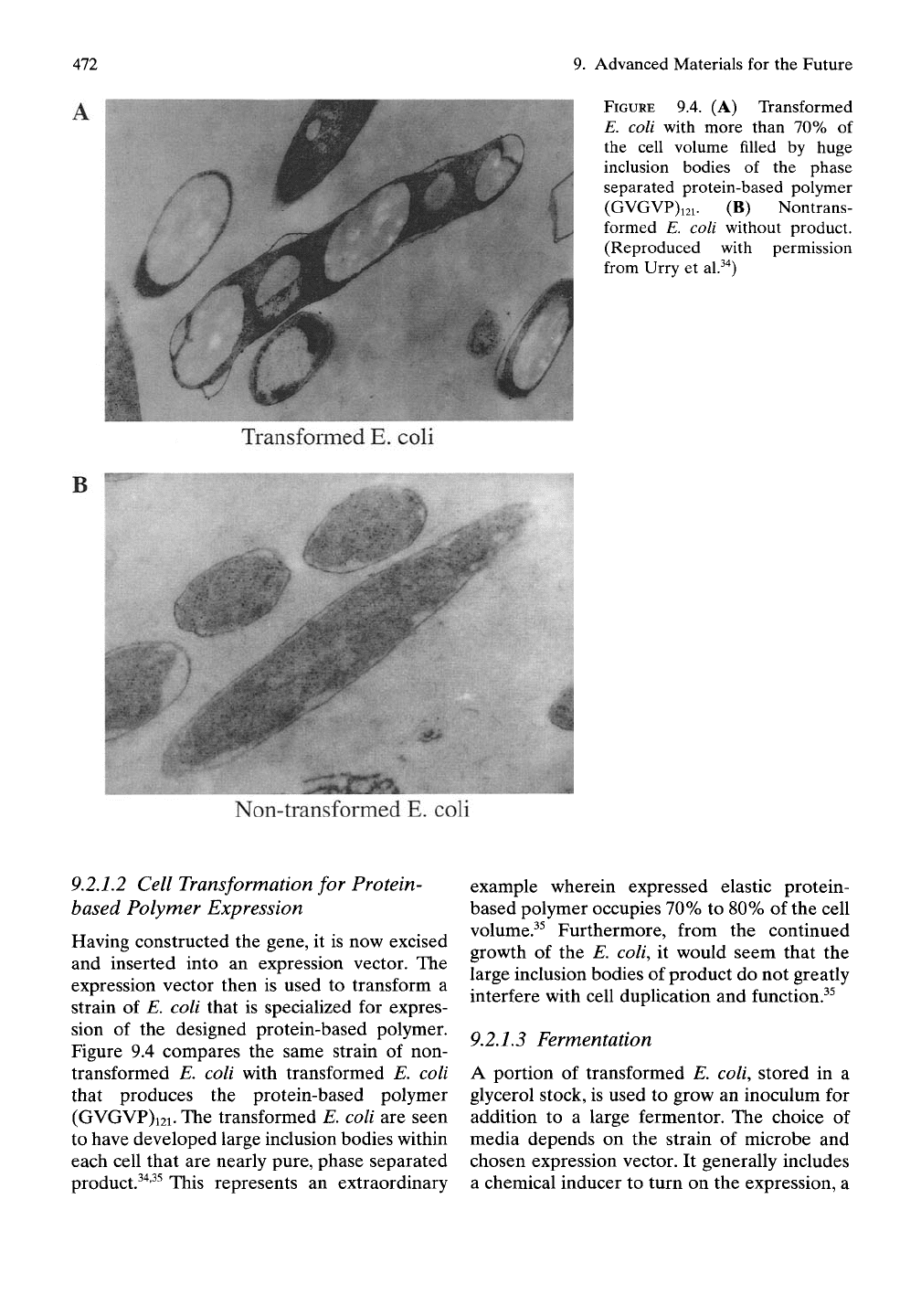
Transformed E. coli
B
9. Advanced Materials
for the
Future
FIGURE
9.4. (A) Transformed
E. coli with more than
70% of
the cell volume filled
by
huge
inclusion bodies
of the
phase
separated protein-based polymer
(GVGVP)i2i.
(B)
Nontrans-
formed
E.
coli without product.
(Reproduced with permission
from Urry
et
al.^"^)
Non-transformed E. coli
9.2.1.2 Cell Transformation
for
Protein-
based Polymer Expression
Having constructed
the
gene,
it is
now excised
and inserted into
an
expression vector.
The
expression vector then
is
used
to
transform
a
strain
of
E. coli that
is
specialized
for
expres-
sion
of the
designed protein-based polymer.
Figure
9.4
compares
the
same strain
of non-
transformed
E.
coli with transformed
E.
coli
that produces
the
protein-based polymer
(GVGVP)i2i. The transformed
E.
coli
are
seen
to have developed large inclusion bodies within
each cell that
are
nearly pure, phase separated
product.^"^'^^ This represents
an
extraordinary
example wherein expressed elastic protein-
based polymer occupies 70%
to
80%
of
the cell
volume.^^ Furthermore, from
the
continued
growth
of the E.
coli,
it
would seem that
the
large inclusion bodies
of
product do not greatly
interfere with cell duplication
and
function.^^
9.2.1.3 Fermentation
A portion
of
transformed
E.
coli, stored
in a
glycerol stock, is used
to
grow
an
inoculum
for
addition
to a
large fermentor.
The
choice
of
media depends
on the
strain
of
microbe
and
chosen expression vector.
It
generally includes
a chemical inducer
to
turn
on
the expression,
a

9.2 Production of Protein-based Polymers
473
carbon source (e.g., glucose or glycerol), a
nitrogen source (often as a source of amino
acids),
salts, other cofactors as may be provided,
for example, by a yeast extract, and an antibi-
otic to which the transformed E. coli are selec-
tively resistant. The fermentor conditions are
optimized with respect to O2 flow, stirring rate,
pH,
and so forth as required for the expression
system.
Fermentors ranging in size from a few liters
to thousands of liters are commercially avail-
able.
In our own case, most commonly a
500
L
fermentor has been used for large
runs.
A single
500
L fermentation of 24 hours can produce
more protein-based polymer than a peptide
chemist can produce in the laboratory in a year.
The product, (GVGVP)25i, of such a single fer-
mentation is shown after phase separation in
Figure 9.5. Furthermore, quality of the fermen-
tation product is greater, in key respects, than
that producible by peptide chemistry.
For production by E. coli there is an impor-
tant issue of the removal of
E.
coli toxic proteins,
particularly, because all animals have abundant
antibodies against E. coli antigens. Because
poly(GVGVP) has been chemically synthesized
and adequately purified, it was established that
these elastic protein-based polymers exhibited
extraordinary biocompatibility. This awareness
provided the impetus for the necessary levels
of purification when using E. c6>//-produced
protein-based polymers, as discussed below.
B
FIGURE
9.5. Elastic-contractile protein
material, (GVGVP)25i, obtained by phase
separation from the ruptured E. coli
cells of a single fermentation run. (A)
Note taffy-like appearance of the mass of
product. (B) Viscoelastic mass being
pulled into a fine strand. (Courtesy of
Bioelastics Research, Ltd.)

474 9. Advanced Materials for the Future
9,2.1.4 Gene Constructions and Expressed below, the protein-based polymers with
Protein-based Polymers methodically varied values of AGap become
primary candidates for systematic control of
Table 9.2 Hsts 79 peptide sequences encoded for ^^ delivery
by basic monomer genes. When n is greater
than 1, the monomer gene has been concate-
merized to form multimer genes, with the ^.2.1.5 Efforts Toward Low-cost
number of repeats of the monomer gene being Production in Other Microbes and
indicated by the value of n, which indicates the in Plants Using Recombinant
size of the gene in a characterized clone of DNA Technology
transformed £". co//.The values of n bearing the r*-i
^
r i AT i.- i n- .i .• A i
r ^. ^ -r- 9.2.1.5.1 Multiple Biosynthetic Approaches
superscript a note expression of that specific A TT j
^ • u ^ ^ rj^' \r Are Underway
protein-based polymer. This represents a
significant stock of transformed E. colt that Efforts to produce elastic protein-based poly-
BRL has designed for specific appUcations. A mers include using tobacco,^^'^^ mushrooms,^^
substantial number of the expressed protein- yeast,^^ and the seeds of arabidopsis,canola, and
based polymers were designed to elucidate ele- soy."^^ Production in tobacco plants has the
ments of the comprehensive hydrophobic effect potential of providing a healthful product from
such as quantifying the apolar-polar repulsive a plant that is the source of much illness, as such
free energy of hydration, AGap. As discussed tobacco farms could be viewed as a capacity
TABLE 9.2. Bioelastics Research, Ltd.: List of gene constructions and expressed protein-based polymers.
L [(GVGVP)io]„(GVGVP): n =
25%
14%
12%
4^
2.
(GVGVP GVGFP GHGFP GVGVP GVGFP GFGFP)n(GVGVP): n =
25%
15,12, 9, 8, 7, 5, 3
3.
(GVGVP GVGFP GKGFP GVGVP GVGFP GFGFP)n(GVGVP): n =
75%
41%
33%
22%
15,12,
6%
5, 2
4.
(GVGVP GVGFP GEGFP GVGVP GVGFP GFGFP)n(GVGVP): n =
42% 32%
17%
14%
8%
6%
4%
3%
2^
5.
(GVGVP GVGFP GDGFP GVGVP GVGFP GFGFP)n(GVGVP): n =
12%
8%
7, 6, 4
6. (GVGVP GVGFP GEGFP GVGVP GVGFP GKGVP)n(GVGVP): n = 40,
21%
20,11%
10, 8, 7
7.
(GVGVP GVGKP GEGFP GVGVP GVGFP GFGVP)n(GVGVP): n = 48,
39%
26, 22% 21, 20,17,15,12, 9, 7
8. (GVGVP GVGFP GEGFP GVGVP GVGVP GKGVP)n(GVGVP): n =
22%
20,18,15,13,11,10, 9, 8, 7, 6, 5, 4
9. (GVGVP GVGKP GEGFP GVGVP GVGVP GFGVP)n(GVGVP): n = 38,
22%
15, 6
10.
[(AVGVP),o]n(GVGVP): n =
29%
7%
4%
2
11.
[(GVGIP)io]n(GVGVP): n = 26% 15%
13%
7%
4^
12.
(GVGIP GFGEP GEGFP GVGVP GFGFP GFGIP GVGIP GFGEP GEGFP GVGVP GFGFP
GFGIP)n(GVGVP): n = 30% 24,20%
13%
11,10, 6, 5
13.
(GVGIP GFGEP GEGFP GVGVP GFGFP GFGIP GVGIP GFGEP GEGFP GVGVP GFGFP GFGIP GVGVP
GVGRGYSLG VP)n(GVGVP): n = 20
14.
(GVGVP GVGFP GEGFP GVGVP GVGFP GVGFP)n(GVGVP): n =
41%
29,15% 12, 9, 7, 6, 3
15.
(GVGVP GVGVP GEGVP GVGVP GVGFP GFGFP)n(GVGVP): n = 60%
39%
24% 15
16.
(GVGVP GVGFP GEGFP GVGVP GVGVP GVGVP)n(GVGVP): n = 40% 25,16,14,10, 8, 7, 6, 5, 4, 3, 2
17.
(GVGVP GVGFP GKGFP GVGVP GVGFP GVGFP)n(GVGVP): n =
21%
12, 6
18.
(GVGVP GVGVP GKGVP GVGVP GVGFP GFGFP)n(GVGVP): n =
45%
22%
20,15,14%
12%
7
19.
(GVGVP GVGFP GKGFP GVGVP GVGVP GVGVP)n(GVGVP): n = 26%
22%
17% 16,14% 13,11,10, 9
20.
[(GVGIP)io-GVGVPGRGDSP-(GVGIP)io]n(GVGVP): n = 21,18% 11^
21.
[(GVGVP)io-GVGVPGRGDSP-(GVGVP)io]n(GVGVP): n = 18%
15%
8^
22.
[(GVGIP)io-GVGVPGRGDSP-(GVGVP)io]n(GVGVP): n =
12%
8^
23.
[(GVGIP)io-GVGRGYSLGIP-(GVGIP)io]n: n =
10%
4^
24.
{[(GGVP)3(GGFP)]3ln: n = 27, 22
25.
GKGKAPGK-[(GVGVP)io]n: n = 10^
26.
GKGKAPGK-[(AVGVP)io]n: n =
20%
5^
27.
[(GVGVP)io(GVGVAP)8(GVGVP)io]n: n =
8%
5%
2,1
28.
[(AFGFPAEGFP)5]n(GVGVP): n = 53, 22,18,16% 14, 6
29.
[(GVGFPGEGFPGFGVP)3]n(GVGVP): n = 30% 14% 12
30.
[(GVGVP)io-GVGVPGNGVP(GVGVP)io]n(GVGVP): n =
10%
5^
